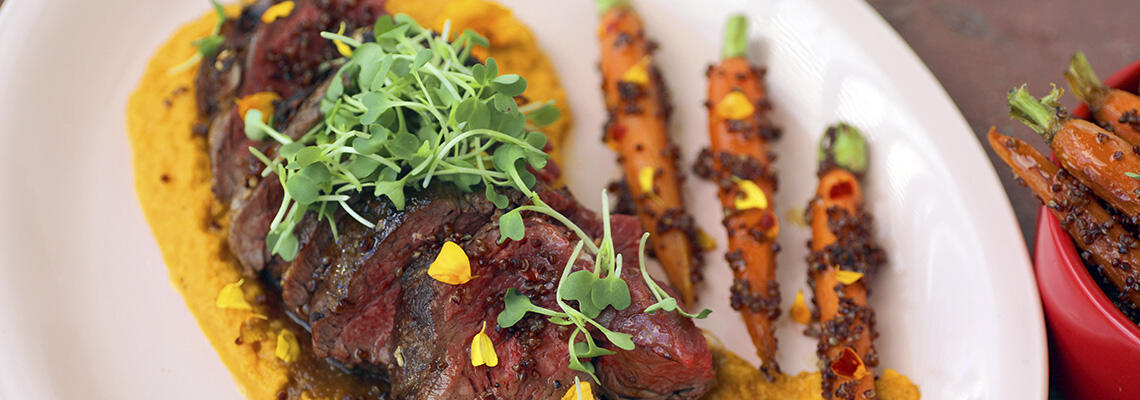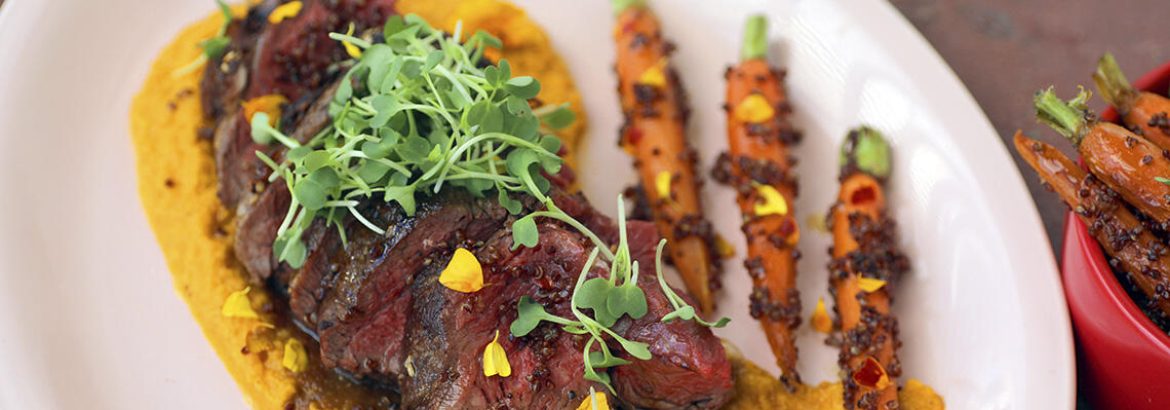

 Entrees
Entrees Gluten Free
Gluten Free Spring
Spring Summer
Summer Winter
Winter| Number of Servings: 4 | |||||||||
| Serving Size 522 grams | |||||||||
| Calories | 180 | ||||||||
| % Daily Value* | |||||||||
| Total Fat 9g | 12% | ||||||||
|
|||||||||
| Cholesterol 0g | 10% | ||||||||
| Sodium 900g | 39% | ||||||||
| Total Carbohydrate 13g | 5% | ||||||||
|
|||||||||
| Protein 11g | |||||||||
|
|||||||||
*The % Daily Value (DV) tells you how much a nutrient in a serving of food contributes to a daily diet. 2,000 calories a day is used for general nutrition advice.
Sauce
2 T olive oil
4 large Markon First Crop (MFC) Peeled French Orange Baby Carrots
1 Markon First Crop Yellow Onion, peeled and chopped roughly
1 T kosher salt
1 tsp. dukkah
1/4 tsp. black pepper
2 cloves Ready-Set-Serve Peeled Garlic
1/4 C Ready-Set-Serve Lemon Juice
3/4 C stock (vegetable or beef)
Beef
2 T olive oil
1/3-lb. beef tenderloin
2 T dukkah
2 tsp. kosher salt
1/2 tsp. black pepper
2 T unsalted butter
Carrots
16 Ready-Set-Serve Baby Carrots
1 T unsalted butter
1 tsp. kosher salt
1/4 C honey
2 C red quinoa, cooked
Edible petals and micro greens for garnish
Preheat oven to 425 degrees F.
Toss carrots and onions with olive oil; season with salt, dukkah, and pepper. Roast in oven until tender, approximately 30 minutes.
Heat two tablespoons oil in cast iron skillet. Season beef liberally with dukkah, salt, and pepper; add to hot skillet, searing each side (two to three minutes per side). Add butter and put pan in the in preheated oven for 15-18 more minutes or until 140 degrees F (for medium rare). Remove and allow meat to rest for 10 minutes.
While meat is in the oven, make the sauce. Place roasted vegetables, garlic, lemon juice, and stock in food processor. Blend until smooth and frothy. Adjust seasonings as needed and set aside.
Add one tablespoon butter to another skillet; when melted, drop in carrots, and season with salt and pepper. Cook on medium-high until carrots are tender and starting to brown. Add honey and toss all. Remove from heat. Dip carrots in quinoa to coat.
To plate, pour carrot sauce over a large/shareable serving dish. Slice beef into 12 slices (three each) and place on top of sauce. Arrange quinoa-coated carrots next to meat. Garnish with more dukkah, edible petals, and micro greens.
1 bunch Markon First Crop Asparagus, steamed
1/4 C Markon First Crop Basil
2 T Markon First Crop Chervil
2 T C Ready-Set-Serve Lemon Juice
2 cloves Ready-Set-Serve Peeled Garlic
1 tsp. lemon zest
1/4 tsp. cumin
1/4 tsp. coriander
1/4 C extra virgin olive oil
1/2 tsp. kosher salt
1/4 tsp. red pepper flakes
16 large shrimp, cleaned and threaded onto skewers to prevent curling
1 tsp. kosher salt
Olive oil + 2 cloves Ready-Set-Serve Peeled Garlic, for poaching
Edible petals and micro greens for garnish
Slice tips off asparagus and reserve. Add basil, chervil, one cup steamed asparagus stalks, lemon juice, zest, cumin, coriander, salt, pepper flakes, and oil to a food processor and blend until chunky.
Heat oil and garlic until just bubbling. Add shrimp skewers so that shrimp is fully submerged. Reduce heat to a simmer and cook until shrimp is opaque and cooked through. When shrimp are almost cooked, add asparagus tips. Remove all with a slotted spoon and drain on a wire rack.
To plate, arrange tips in a decorative manner. Place shrimp next to asparagus and ladle sauce on top of each one. Garnish with edible petals and micro greens.
With its blend of French and Vietnamese cuisine, this delicious sandwich is accessible to most menus.
Chinese steamed buns, bao, are small, fluffy meat- and vegetable-stuffed treats that lend themselves to many variations.
Sweet and salty, this fruit and cheese salad balances a unique blend of flavors your customers will crave.